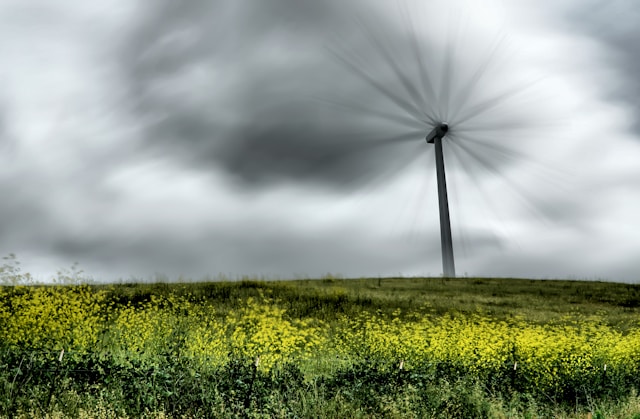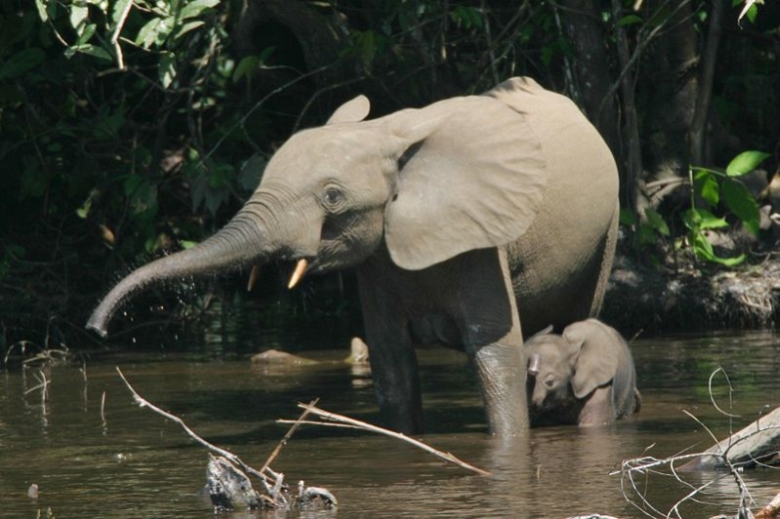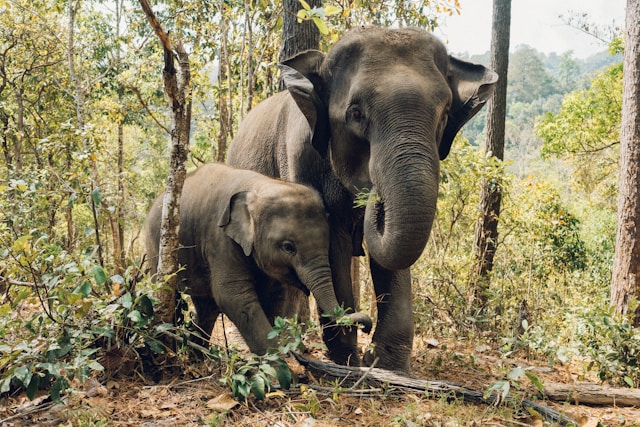
by Deep Green Resistance News Service | Mar 21, 2013 | Biodiversity & Habitat Destruction, Climate Change, NEWS
By Root Force
A series of recently released studies make it clear that wind power is not going to save us—not from global warming, not from high extinction rates, and not from the system of high-energy-consumption industrial exploitation that is killing the planet.
Let’s start with the most damning findings: even the most large-scale shift to wind power cannot slow greenhouse gas emissions enough to have any positive effect on the climate, although it may manage to make things worse. Why?
A study published in Nature Climate Change in September found that although hypothetically there is enough power in the earth’s winds to sustain current levels of energy consumption, in practice you could never harvest enough energy from wind to affect the climate:
Turbines create drag, or resistance, which removes momentum from the winds and tends to slow them. As the number of wind turbines increases, the amount of energy that is generated increases. But at some point, the winds would be slowed so much that adding more turbines will not generate more electricity. …
[T]he study found that the climate effects of extracting wind energy at the level of current global demand would be small, as long as the turbines were spread out and not clustered in just a few regions. At the level of global energy demand, wind turbines might affect surface temperatures by about 0.2 degrees Fahrenheit and affect precipitation by about 1 percent. Overall, the environmental impacts would not be substantial. (emphasis added)
Another study, published in Nature last month, found that wind farms being constructed in Scotland actually lead to a net increase in carbon dioxide emissions:
Wind farms are typically built on upland sites, where peat soil is common. In Scotland alone, two thirds of all planned onshore wind development is on peatland. England and Wales also have large numbers of current or proposed peatland wind farms.
But peat is also a massive store of carbon, described as Europe’s equivalent of the tropical rainforest. Peat bogs contain and absorb carbon in the same way as trees and plants — but in much higher quantities.
British peatland stores at least 3.2 billion tons of carbon, making it by far the country’s most important carbon sink and among the most important in the world.
Wind farms, and the miles of new roads and tracks needed to service them, damage or destroy the peat and cause significant loss of carbon to the atmosphere, where it contributes to climate change. …
Richard Lindsay of the University of East London, said … “The world’s peatlands have four times the amount of carbon than all the world’s rainforests. But they are a Cinderella habitat, completely invisible to decision- makers.”
Finally, a study published last month in the journal Environmental Research Letters conducted a further analysis on the effects of wind turbine drag:
Each wind turbine creates behind it a “wind shadow” in which the air has been slowed down by drag on the turbine’s blades. The ideal wind farm strikes a balance, packing as many turbines onto the land as possible, while also spacing them enough to reduce the impact of these wind shadows. But as wind farms grow larger, they start to interact, and the regional-scale wind patterns matter more.
Keith’s research has shown that the generating capacity of very large wind power installations (larger than 100 square kilometers) may peak at between 0.5 and 1 watts per square meter. Previous estimates, which ignored the turbines’ slowing effect on the wind, had put that figure at between 2 and 7 watts per square meter.
In short, we may not have access to as much wind power as scientists thought.
“If wind power’s going to make a contribution to global energy requirements that’s serious, 10 or 20 percent or more, then it really has to contribute on the scale of terawatts in the next half-century or less,” says Keith.
If we were to cover the entire Earth with wind farms, he notes, “the system could potentially generate enormous amounts of power, well in excess of 100 terawatts, but at that point my guess, based on our climate modeling, is that the effect of that on global winds, and therefore on climate, would be severe — perhaps bigger than the impact of doubling CO2.” (emphasis added)
As if that weren’t enough, another study has just concluded that large wind turbines constructed offshore may snap like matches when hit by medium-size waves:
“If we do not take ringing into consideration, offshore wind turbine parks can lead to financial ruin,” warns John Grue to the research magazine Apollon at University of Oslo. …
Ringing does not just harm wind turbines. Ringing has already been a great problem for the oil industry. The designers of the YME platform did not take ringing into account, and lost NOK 12 billion.
“It is possible to build your way out of the ringing problem by strengthening the oil rigs. However, it is not financially profitable to do the same with wind turbines,” says John Grue.
And finally, let’s not forget what environmentalists have been warning about for decades: wind turbines murder birds.
ReWire has learned that the North Sky River Wind project, which attracted fierce opposition from environmental groups concerned about potential threat to eagles and California condors, was the site of a golden eagle death in January. …
The eagle kill apparently occurred on January 29, just a month after North Sky River started generating power.
So what’s the solution? Certainly not wind, solar, or any other industrial magic bullet. The solution is to dramatically scale back consumption and shift to local-based economies not dependent upon stealing resources from distant people and lands.
The solution is to demolish the global economic system.
Get started!
Photo by Casey Horner on Unsplash

by Deep Green Resistance News Service | Mar 9, 2013 | Biodiversity & Habitat Destruction
By Mongabay
More than 60 percent of Africa’s forest elephants have been killed in the past decade due to the ivory trade, reports a new study published in the online journal PLOS ONE.
The study warns that the diminutive elephant species — genetically distinct from the better-known savanna elephant — is rapidly heading toward extinction.
“The analysis confirms what conservationists have feared: the rapid trend towards extinction – potentially within the next decade – of the forest elephant,” said study co-author Samantha Strindberg of the Wildlife Conservation Society (WCS).
“Saving the species requires a coordinated global effort in the countries where elephants occur – all along the ivory smuggling routes, and at the final destination in the Far East,” added co-author Fiona Maisels, also of WCS. “We don’t have much time before elephants are gone.”
The study is based on the largest-ever set of survey data across five forest elephant range countries: Cameroon, Central African Republic, the Democratic Republic of Congo, Gabon and the Republic of Congo. The study involved more than 60 scientists who spent 91,600 person-days surveying for elephants, walking over 13,000 kilometers (more than 8,000 miles).
The study shows that elephants are increasingly scarce in areas with “high human density, high infrastructure density such as roads, high hunting intensity, and poor governance”, according to a statement from WCS.“Historically, elephants ranged right across the forests of this vast region of over 2 million square kilometers (over 772,000 square miles), but now cower in just a quarter of that area,” said co-author John Hart of the Lukuru Foundation. “Although the forest cover remains, it is empty of elephants, demonstrating that this is not a habitat degradation issue. This is almost entirely due to poaching.”
The decline in elephant populations has significant implications for the forest ecosystem. Elephants are considered “architects of the forest” for the role in opening clearings and maintain trails.
“A rain forest without elephants is a barren place,” explained Lee White. “They bring it to life, they create the trails and keep open the forest clearings other animals use; they disperse the seeds of many of the rainforest trees – elephants are forest gardeners at a vast scale. Their calls reverberate through the trees reminding us of the grandeur of primeval nature. If we do not turn the situation around quickly the future of elephants in Africa is doomed. These new results illustrate starkly just how dramatic the situation has become. Our actions over the coming decade will determine whether this iconic species survives.”
by Deep Green Resistance News Service | Feb 25, 2013 | Agriculture, Biodiversity & Habitat Destruction
By Jeremy Hance / Mongabay
Industrial oil palm plantations are spreading from Malaysia and Indonesia to the Congo raising fears about deforestation and social conflict.
A new report by The Rainforest Foundation UK (RFUK), dramatically entitled The Seeds of Destruction, announces that new palm oil plantations in the Congo rainforest will soon increase fivefold to half a million hectares, an area nearly the size of Delaware. But conservationists warn that by ignoring the lessons of palm oil in Southeast Asia, this trend could be disastrous for the region’s forests, wildlife, and people.
“Governments of Congo Basin countries have handed out vast tracts of rainforest for the development of palm oil with apparently little or no attention to the likely impacts on the environment or on people dependent on the forest,” Simon Counsell, Executive Director of the Rainforest Foundation UK, said.
The palm tree used to produce palm oil originated in Africa, so production in the Congo Basin isn’t new. But industrial palm oil production involving massive plantations is a recent development for the region. The approach, modeled after operations in Southeast Asia, raises concerns among environmentalists who argue that palm oil has been a disaster for the forests of Malaysia and Indonesia. Indeed, scientific research has found that between 1990 and 2000, 86 percent of all deforestation in Malaysia was for palm oil.
The largest palm oil developer in the Congo Basin is currently Malaysian-owned Atama Plantations SARL, which is working to establish a 180,000-hectare (450,000-acre) plantation in the Republic of Congo. But the entire enterprise is masked by a complete lack of transparency, says the report.
“No publicly available maps of the concession are available, but evidence suggests that the forests designated for clearance mostly appear to be virgin rainforest that is habitat for numerous endangered species, including chimpanzees and gorillas. The area borders, and some of it may fall inside, a planned National Park and Ramsar site,” according to the RFUK report, which notes that logging has already begun on the concession.
The RFUK report further questions whether the plantation development is simply an excuse to log what it calls “primary forests with significant timber stocks.”
Another controversial concession, this time in Cameroon, has received considerable pushback from international NGOs as well as local groups. U.S.-based Herakles Farms is working to develop a 60,000 hectare palm oil plantation in forest bordering four protected areas, but the company’s reputation has been tarnished by local protests, as well as condemnation from international groups such as Greenpeace. Last year, 11 top tropical biologists sent an open letter to Herakles condemning the project.
But Herakles and other companies say they are bringing economic development to a notoriously poor part of the world.
The RFUK report notes that in many cases governments appear unwilling even to take advantage of the economic benefits of palm oil plantations, by overly-sweetening deals to foreign corporations.
“The contracts signed between governments and oil palm developers are being kept secret, reducing transparency and democratic accountability. Those contracts that have come to light show that governments have already signed away some of the potential economic benefits, by granting developers extremely generous tax breaks of 10 to 16 years and land for ‘free’ or at highly discounted rates,” the report reads.
In addition, the palm oil plantations are sparking local conflict with traditional landowners, much as they have done in Malaysia and Indonesia. Locals often have little input on the project and in some cases leases are extraordinarily long, for example Herakles Farms’ lease is 99 years.
“New large-scale oil palm developments are a major threat for communities, livelihoods and biodiversity in the Congo Basin,” Samuel Nguiffo, Director of the Center for Environment and Development (CED), Cameroon, said. “It is absolutely not the appropriate answer to the food security and job creation challenges the countries are facing. Supporting small-scale family agriculture is a better solution.”
by Deep Green Resistance News Service | Feb 24, 2013 | Biodiversity & Habitat Destruction, Climate Change
By Andrew Gilligan / The Telegraph
Thousands of Britain’s wind turbines will create more greenhouse gases than they save, according to potentially devastating scientific research to be published later this year.
The finding, which threatens the entire rationale of the onshore wind farm industry, will be made by Scottish government-funded researchers who devised the standard method used by developers to calculate “carbon payback time” for wind farms on peat soils.
Wind farms are typically built on upland sites, where peat soil is common. In Scotland alone, two thirds of all planned onshore wind development is on peatland. England and Wales also have large numbers of current or proposed peatland wind farms.
But peat is also a massive store of carbon, described as Europe’s equivalent of the tropical rainforest. Peat bogs contain and absorb carbon in the same way as trees and plants — but in much higher quantities.
British peatland stores at least 3.2 billion tons of carbon, making it by far the country’s most important carbon sink and among the most important in the world.
Wind farms, and the miles of new roads and tracks needed to service them, damage or destroy the peat and cause significant loss of carbon to the atmosphere, where it contributes to climate change.
Writing in the scientific journal Nature, the scientists, Dr Jo Smith, Dr Dali Nayak and Prof Pete Smith, of Aberdeen University, say: “We contend that wind farms on peatlands will probably not reduce emissions …we suggest that the construction of wind farms on non-degraded peats should always be avoided.”
Dr Nayak told The Telegraph: “Our full paper is not yet published, but we should definitely be worried about this. If the peatland is already degraded, there is no problem. But if it is in good condition, we should avoid it.”
Another peat scientist, Richard Lindsay of the University of East London, said: “If we are concerned about CO2, we shouldn’t be worrying first about the rainforests, we should be worrying about peatlands.
“The world’s peatlands have four times the amount of carbon than all the world’s rainforests. But they are a Cinderella habitat, completely invisible to decision- makers.”
One typical large peat site just approved in southern Scotland, the Kilgallioch wind farm, includes 43 miles of roads and tracks. Peat only retains its carbon if it is moist, but the roads and tracks block the passage of the water.
The wind industry insists that it increasingly builds “floating roads,” where rock is piled on a textile surface without disturbing the peat underneath.
But Mr Lindsay said: “Peat has less solids in it than milk. The roads inevitably sink, that then causes huge areas of peatland to dry out and the carbon is released.”
Mr Lindsay said that more than half of all British onshore wind development, current and planned, is on peat soils.
In 2011 the Scottish government’s nature protection body, Scottish Natural Heritage, said 67 per cent of planned onshore wind development in Scotland would be on peatland.
Read more from The Telegraph: http://www.telegraph.co.uk/earth/energy/windpower/9889882/Wind-farms-will-create-more-carbon-dioxide-say-scientists.html

by Deep Green Resistance News Service | Feb 20, 2013 | Agriculture, Biodiversity & Habitat Destruction, NEWS
By Jeremy Hance / Mongabay
A biofuel plantation near Yala National Park has landed Lanka Orex Leasing Company PLC (LOLC) in Sri Lanka’s highest court. Environmentalists say the company is illegally bulldozing Asian elephant habitat, including scrubland and tree stands, near the buffer zone of Yala National Park for gliricidia (Gliricidia sepium) biofuel plantation.
“This is going to be a permanent cultivation within the home range of few elephant herds,” Vimukthi Weeratunga, Environmental Foundation Limited (EFL)’s head of operations and environmental scientist, told mongabay.com. “When we take the elephant land by developing this area, elephants will move to nearby villages to raid crop as they cannot use this area for their normal activities. This is exactly the way that human-elephant conflict increased in the other parts of Sri Lanka.”
Located near the buffer zone of Yala National Park, Weetatunga states that company never conducted an environmental impact assessment (EIA), transgressing Sri Lankan law. In addition, the Sri Lanka’s Forest Department has repeatedly denied leasing the land to the company in local press, instead it gave 500 hectares (1,250 acres) to local dairy farmers for rearing cattle. Lanka Orex Leasing Company PLC was merely supposed to provide “technical assistance” to the farmers.
The site in question is currently used by smallscale farmers for cattle and farming, but Weetatunga says that this doesn’t mean the ecosystem is degraded. Instead, he says smallscale farming and livestock in the area are actually important for elephants as opposed to a monoculture plantation.
“Shifting cultivation is a traditional farming practice by clearing some scrubland and leave after the harvest for forest to re-grow. This practice is ideal for elephants to thrive as they get high quality fodder after people leave to regrow,” he explains. Between 2,000 and 4,500 Asian elephants (Elephas maximus) roam Sri Lanka’s forests. The species is currently listed as Endangered by the IUCN Red List.
The area in question is home to many other species as well, including leopards, fishing cats, sloth bears, pangolins, and a large variety of birds.
Many have noted in Sri Lankan press the irony of destroying elephant habitat, including forest lands, for so-called green energy made from biofuels. Gliricidia is a woody plant that can be burned in a biofuel power plant.
The Environmental Foundation Limited (EFL) is currently awaiting a court date next month with Lanka Orex Leasing Company over the habitat clearing.
“We are asking [for an] injunction of current activities,” Weetatunga says. “We are also seeking compensation for their action if we win the case.”
Last year, environmentalists in Sri Lanka caught U.S. food giant Dole clearing forest in Somawathiya National Park for a banana plantation. Dole denied it was inside the park for months, but finally abandoned the project after threat of lawsuit.
Like many Southeast Asian countries, Sri Lankan is currently undergoing a tension between large-scale industrial projects, such as monoculture plantations, and local farming and conservation efforts.

by Deep Green Resistance News Service | Feb 14, 2013 | Agriculture, Biodiversity & Habitat Destruction
By John Vidal / The Guardian
Nearly one in five of the world’s estimated 10,000 species of lizards, snakes, turtles, crocodiles and other reptiles are threatened with extinction, according to a study conducted by 200 experts.
But the risk of extinction was found to be unevenly spread throughout the extremely diverse group of animals. According to the paper, an alarming 50% of all freshwater turtles are close to extinction, possibly because they are traded on international markets.
The study, published by the Zoological Society of London in conjunction with the IUCN species survival commission, is the first of its kind summarising the global conservation status of reptiles, and used 1,500 randomly selected reptiles worldwide.
Out of the estimated 19% of reptiles threatened with extinction, in order of magnitude of danger, 12% are classified as critically endangered, 41% endangered and 47% vulnerable.
Three species were found to be possibly extinct. One, a jungle runner lizard, Ameiva vittata, has only ever been recorded in one part of Bolivia. In Haiti, six of the nine species of anolis lizard included in this study have an elevated risk of extinction, due to extensive deforestation affecting the country.
The spread of farming and deforestation in tropical regions represents two of the greatest threats to reptiles, says the paper.
Read more from The Guardian: http://www.guardian.co.uk/environment/2013/feb/15/reptile-species-face-extinction




